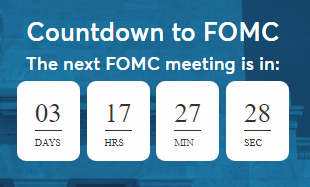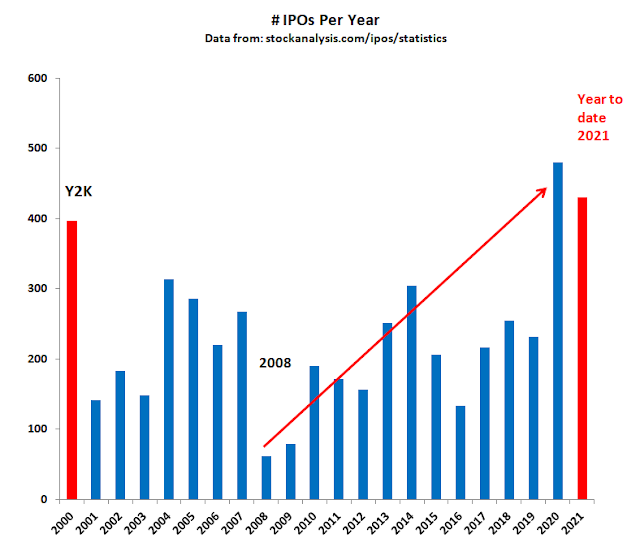"The median short interest in members of the S&P 500 sits at just 1.6% of market value, near a 17-year low"
Tuesday, April 27, 2021
The Calm Before The 100 Year Storm
"The median short interest in members of the S&P 500 sits at just 1.6% of market value, near a 17-year low"
Monday, April 26, 2021
Lethal Asset Hyperinflation
The sheeple at large have lethally conflated an asset hyperinflation bubble for a traditional wage price spiral. They've had ample assistance from those who are more than happy to offload over-valued assets at asinine prices...
This current paradigm is nothing like true inflation as defined by a cost of living wage price spiral. In order to have a wage price spiral, one must have wages increasing at an accelerating rate. Not depressed by mass unemployment. In addition, under true inflation financial assets - stocks and bonds - get destroyed by the reduced discounted value of future payments. Does that sound like this type of inflation? Of course not. This is a lethal asset hyperinflation bubble rotating from one asset class to the next. And the dominoes are falling.
Most articles on Zerohedge are worthless these days, because not unlike the mainstream media, the quality of their content has declined inversely with the growth of their lowest common denominator subscriber base. Nevertheless, this one by The Burning Platform cut through some of the monetary haze surrounding this lethal hyperinflation bubble. The author describes how a condo that languished below 2004 prices for 14 years, suddenly gained 60% in the past two years. Then he talks about the baseball card craze and how small pieces of cardboard are suddenly gaining tens of thousands in "value". Does anyone actually believe there is a shortage of basecall cards? Apparently, the site that values these sports collectibles stopped taking new customers because they've been inundated with new clients eager to value (aka. "sell") their old baseball cards.
Remember a year ago when there was a toilet paper shortage at the beginning of the lockdown period?
The article below is a reminder from March of last year. Several reasons for the shortage are given, but the one that resonates is that panic buying creates more panic buying. In other words, what they are describing is the hoarding mentality that accompanies a TRUE hyperinflationary environment - one in which prices are higher week after week. There is only one problem, the shortage was temporary. If there was true hyperinflation, the cost of toilet paper would be skyrocketing not due to a lack of supply but because the dollar would be collapsing in value.
"Images of empty shelves and shopping carts piled high with supplies have inundated news reports and social feeds. People see images of panic buyers, assume there's a reason to panic and buy up supplies, too"
Of course there was no actual shortage of toilet paper. Manufacturers quickly figured out how to make more of it. In fact, last year's shortage has turned into this year's glut:
One year later:
"Kimberly-Clark Corp. reported a sharp drop in toilet paper sales and warned the coronavirus pandemic-fueled surge in demand for its products was slowing."
The number of assholes keeps growing at an exponential rate, and yet toilet paper demand is slowing. A modern paradox.
Where was I...
Unlike general price inflation, an asset hyperinflation bubble can implode overnight, destroying asset values. Central banks didn't have to do a thing for Gamestop to implode. Next went Biotechs, Ark ETFs, EV SPACs, Fintechs, Cloud computing etc. Central banks didn't raise interest rates nor change their QE policies in the least.
The toilet paper scenario is a warning of what's coming when this hyperinflation asset bubble fully unwinds - a glut of everything.
Gold, which is the true protection from inflation, is warning that there is no sustainable inflation. Gold started rallying in 2019 when the Fed was cutting rates, but then it ran out of gas last summer. One of the first asset bubbles to roll over. In my opinion it has substantial downside from these levels.
All of these bubbles are predicated on the basis that the dollar is losing its value. Permanently. Which is the fundamental basis behind true hyperinflation.
However, the dollar is merely lurking behind the scenes of the massive margin expansion.
What people forget from last year, is that one of the first order effects of the pandemic crash was that the dollar ripped higher.
We are seeing a very similar headfake pattern play out this year:
When the dollar rips higher, today's assets will become liabilities. At that point, low interest rates won't matter. Only return of principal will matter. There will be a global liquidity crisis unlike anything we've seen in our lifetimes.
Those who are predicting the death of the dollar will get their heads ripped off. Again.
Saturday, April 24, 2021
Bernie Madoff's Market
Thursday, April 22, 2021
ALL WARNINGS IGNORED.
Wednesday, April 21, 2021
Nothing Matters Until It Explodes Spectacularly
Tuesday, April 20, 2021
Pigs To The Slaughter
In what can only be described as human history's biggest mass con job, central banks have systematically desensitized gamblers to all risk. They are now cycle high fat, dumb, and happy. I call it monetary euthanasia...
Compliments of central bank alchemy, the shortest bear market in history yielded the best one year market gain to an all time high in market history. In addition, inflation expectations are the highest since the end of the last cycle, retail investor speculation is cycle high, and now we learn that the market is two decade overbought.
All late cycle indicators peaking at "the beginning of a new cycle".
One of the indicators I haven't shown recently, shows the ratio of mid cap stocks to the large cap Dow. What we see is that mid caps peak relatively early, they underperform for a while and then they burst higher at the end of the cycle due to short covering. In addition, commodity stocks (second pane) outperform at the end of the cycle and of course inflation expectations are highest at the end of the cycle:
This fraudulent recovery which is based solely upon asset inflation has seen some ludicrous moves in asset prices. However, few sectors are as insane as the retail sector which was blighted by the pandemic. And yet, it's the top performing sector over the past year. This entire sector has been "Gamestopped" higher amid record store closures.
Which has fulfilled the circular mirage of "recovery" based upon capital misallocation.
Another thing you don't see at the beginning of a cycle is cycle high IPO/SPAC issuance:
Herein lies the problem:
Over the course of this 12 year continuous monetary bailout cycle, investors have become more and more complacent. I use a ratio of NYSE down volume over up volume to show the degree of panic selling.
Back in 2008 when it was the end of the cycle, panic selling peaked. Subsequently, we have seen lower peaks over the course of the cycle. We are to believe that the lowest level of selling in the entire cycle marks the beginning of a new cycle.
Sure.
What we are about to witness is 12 years of pent up selling, which will make 2008 look like a picnic.
And then everyone will know what we know. It's the end of the cycle.
And this is no time for bullshit from the same proven assholes who lied last time.
Monday, April 19, 2021
This Orgy Of Excess. Is Leveraged To DogeCoin
We still don't know why the cryptos crashed. It could be that the last fool was found. Like Gamestop, cryptos are uniquely suited to the Congressionally approved Ponzi investment strategies hatched on Reddit...
The intended design behind Bitcoin and other cryptos is to create scarcity. As price moves higher, the amount of supply becomes increasingly constrained by the mining algorithms, difficulty level, and available hashrate/computing power. Therefore, liquidity becomes constrained as well. These were precisely the conditions that attended the massive Gamestop short squeeze. However, the scarcity factor for Gamestop came from the fact that hedge funds had borrowed the shares and were forced to buy them back. Low liquidity is a critical requirement for parabolic price moves, but unfortunately it cuts both ways. Which is why Bitcoin is known for its two way volatility. It will never be a stable currency. It's a speculative toy. The rest of the cryptos are even worse. There are now over 6700 cryptos and they are proliferating like rabbits. The fact that they are all 100% correlated should serve as a warning sign to speculators.
New "flash loans" are allowing crypto speculators to use cryptos as collateral to buy other cryptos. In the same way that 2007 era subprime CDOs were built upon other subprime CDOs creating instantly exploding CDO "squared", which had the shelf life of a rotten banana.
We now have a similar thing in Crypto Ponzi schemes:
“In a way, flash loans make everyone a whale” said Nikola Jankovic, community manager at flash loan provider DeFi Saver, referring to the crypto industry nickname for large investors who are often able to move markets by themselves."
Leveraged cryptos are the ultimate form of speculation. It's the crack cocaine of gambling, so it should come as no surprise that the crypto bubble is one of the last and largest speculative bubbles to burst.
Ponzi King Mike Novogratz warned last week that we are seeing a blow-off top in crypto speculation:
"I've seen a lot of weird coins like dogecoin and even XRP have huge retail spikes, which means there's a lot of frenzy right now."
"In the next week, certainly we could have some volatility because of the excitement around Coinbase."
Indeed, we have already started to see some volatility. I showed this chart below on my Twitter feed which overlays the Google trends search term "Crypto", onto a graph of the Global Dow. As we see, they peaked simultaneously in 2018. This time, crypto searches peaked back in February with the Nasdaq and is having a double top now with the Global Dow. We also see that margin debt peaked in early 2018 when the crypto bubble exploded. This time however, a "washout" in crypto could have carry-over effects into mainstream financial markets. Why? Because now, BitCon has gone mainstream and is the "most crowded" hedge fund trade of 2021. In addition, Robinhood now allows stock gamblers to buy cryptos on their platform.
It's the equivalent to linking the U.S. banking system to the subprime housing market in a speculative housing mania. It's a bad idea, considering there is now record margin debt AND crypto is a $2 trillion market cap - almost three times larger than in 2018. It's a disaster wanting to happen.
The way I see it, the same way Gamestop fueled a manic reach for risk that exploded in February, the Coinbase IPO fueled a manic reach for risk that is peaking now.
The question on the table is if a $20 billion pump and dump scheme almost crashed the market, what does that portend for a $2 trillion pump and dump scheme that is 100x larger?
Feb. 17th, 2021:
April 17th, 2021:
“It’s reminiscent of GameStop”
Indeed.















































